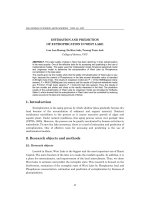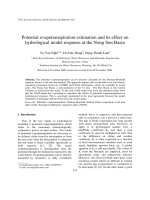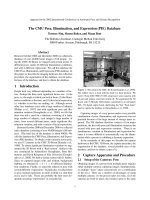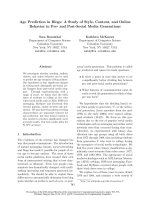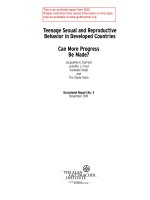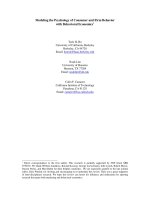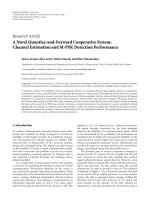Head pose estimation and attentive behavior detection
Bạn đang xem bản rút gọn của tài liệu. Xem và tải ngay bản đầy đủ của tài liệu tại đây (1.74 MB, 81 trang )
Head Pose Estimation and Attentive Behavior
Detection
Nan Hu
B.S.(Hons.), Peking University
A THESIS SUBMITTED
FOR THE DEGREE OF MASTER OF ENGINEERING
DEPARTMENT OF
ELECTRICAL AND COMPUTER ENGINEERING
NATIONAL UNIVERSITY OF SINGAPORE
2005
Acknowledgements
I express sincere thanks and gratefulness to my supervisor Dr. Weimin Huang, Institute for Infocomm Research, for his guidance and inspiration throughout my graduate
career at National University of Singapore. I am truly grateful for his dedication to
the quality of my research, and his insightful prospectives on numerous prospectives
on numerous technical issues.
I am very much grateful and indebted to my co-supervisor Prof. Surendra Ranganath, ECE department of Nationl University of Singapore, for his suggestions on the
key points of my projects and the helpful comments during my paper work.
Thanks are also due to the I2 R Visual Understanding Lab, Dr. Liyuan Li, Dr.
Ruihua Ma, Dr. Pankaj Kumar, Mr. Ruijiang Luo, Mr. Lee Beng Hai, to name a few,
for their help and encouragement.
Finally, I would like to express my deepest gratitude to my parents, for the
continuous love, support and patience given to me. Without them, this thesis could
not have been accomplished. I am also very thankful to friends and relatives with
whom I have been staying. They never failed to extend their helping hand whenever I
went through stages of crisis.
2
Contents
1 Introduction
1
1.1
Motivation . . . . . . . . . . . . . . . . . . . . . . . . . . . . . . . . . .
1
1.2
Applications . . . . . . . . . . . . . . . . . . . . . . . . . . . . . . . . .
2
1.3
Our Approach . . . . . . . . . . . . . . . . . . . . . . . . . . . . . . . .
4
1.3.1
HPE Method . . . . . . . . . . . . . . . . . . . . . . . . . . . .
4
1.3.2
CPFA Method
. . . . . . . . . . . . . . . . . . . . . . . . . . .
5
Contributions . . . . . . . . . . . . . . . . . . . . . . . . . . . . . . . .
7
1.4
2 Related Work
9
2.1
Attention Analysis . . . . . . . . . . . . . . . . . . . . . . . . . . . . .
9
2.2
Dimensionality Reduction . . . . . . . . . . . . . . . . . . . . . . . . .
11
2.3
Head Pose Estimation . . . . . . . . . . . . . . . . . . . . . . . . . . .
14
2.4
Periodic Motion Analysis . . . . . . . . . . . . . . . . . . . . . . . . . .
16
3 Head Pose Estimation
3.1
21
Unified Embedding . . . . . . . . . . . . . . . . . . . . . . . . . . . . .
22
3.1.1
22
Nonlinear Dimensionality Reduction . . . . . . . . . . . . . . .
i
3.1.2
3.2
3.3
Embedding Multiple Manifolds . . . . . . . . . . . . . . . . . .
25
Person-Independent Mapping . . . . . . . . . . . . . . . . . . . . . . .
29
3.2.1
RBF Interpolation . . . . . . . . . . . . . . . . . . . . . . . . .
29
3.2.2
Adaptive Local Fitting . . . . . . . . . . . . . . . . . . . . . . .
31
Entropy Classifier . . . . . . . . . . . . . . . . . . . . . . . . . . . . . .
33
4 Cyclic Pattern Frequency Analysis
35
4.1
Similarity Matrix . . . . . . . . . . . . . . . . . . . . . . . . . . . . . .
36
4.2
Dimensionality Reduction and Fast Algorithm . . . . . . . . . . . . . .
37
4.3
Frequency Analysis . . . . . . . . . . . . . . . . . . . . . . . . . . . . .
41
4.4
Feature Selection . . . . . . . . . . . . . . . . . . . . . . . . . . . . . .
43
4.5
K-NNR Classifier . . . . . . . . . . . . . . . . . . . . . . . . . . . . . .
44
5 Experiments and Discussion
5.1
46
HPE Method . . . . . . . . . . . . . . . . . . . . . . . . . . . . . . . .
46
5.1.1
Data Description and Preprocessing . . . . . . . . . . . . . . . .
47
5.1.2
Pose Estimation . . . . . . . . . . . . . . . . . . . . . . . . . . .
48
5.1.3
Validation on real FCFA data . . . . . . . . . . . . . . . . . . .
51
5.2
CPFA Method . . . . . . . . . . . . . . . . . . . . . . . . . . . . . . . .
54
5.3
Data Description and Preprocessing . . . . . . . . . . . . . . . . . . . .
54
5.3.1
Classification and Validation . . . . . . . . . . . . . . . . . . . .
55
5.3.2
More Data Validation
. . . . . . . . . . . . . . . . . . . . . . .
56
5.3.3
Computational Time . . . . . . . . . . . . . . . . . . . . . . . .
57
ii
5.4
Discussion . . . . . . . . . . . . . . . . . . . . . . . . . . . . . . . . . .
58
6 Conclusion
60
Bibliography
62
iii
Summary
Attentive behavior detection is an important issue in the area of visual understanding
and video surveillance. In this thesis, we will discuss the problem of detecting a frequent
change in focus of human attention(FCFA) from video data. People perceive this kind
of behavior(FCFA) as temporal changes of human head pose, which can be achieved by
rotating the head or rotating the body or both. Contrary to FCFA, an ideally focused
attention implies that the head pose remains unchanged for a relatively long time. For
the problem of detecting FCFA, one direct solution is to estimate the head pose in each
frame of the video sequence, extract features to represent FCFA behavior, and finally
detect it. Instead of estimating the head pose in every frame, another possible solution
is to use the whole video sequence to extract features such as a cyclic motion of the
head, and then devise a method to detect or classify it.
In this thesis, we propose two methods based on the above ideas. In the first method,
called the head pose estimation(HPE) method, we propose to find a 2-D manifold for
each head image sequence to represent the head pose in each frame. One way to build
a manifold is to use a non-linear mapping method called the ISOMAP to represent
the high dimensional image data in a low dimensional space. However, the ISOMAP
is only suitable to represent each person individually; it cannot find a single generic
manifold for all the person’s low dimensional embeddings. Thus, we normalize the 2-D
embeddings of different persons to find a unified head pose embedding space, which
is suitable as a feature space for person independent head pose estimation. These
features are used in a non-linear person-independent mapping system to learn the
iv
parameters to map the high dimensional head images into the feature space. Our nonlinear person-independent mapping system is composed of two parts: 1) Radial Basis
Function (RBF) interpolation, and 2) an adaptive local fitting technique. Once we
get these 2-D coordinates in the feature space, the head pose is very simply calculated
based on these coordinates. The results show that we can estimate the orientation
even when the head is completely turned back to the camera. To extend our HPE
method to detect FCFA behavior, we propose to use an entropy-based classifier. We
estimate the head pose angle for every frame of the sequence, and calculate the head
pose entropy over the sequence to determine whether the sequence exhibits either FCFA
or focused attention behavior. The experimental results show that the entropy value
for FCFA behavior is very distinct from that for the focused attention behavior. Thus
by setting an experimental threshold on the entropy value we can successfully detect
FCFA behavior. In our experiment, the head pose estimate is very accurate compared
with the “ground truth”. To detect FCFA, we test the entropy-based classifier on 4
video sequences, by setting an easy threshold, we classify FCFA from focused attention
by an accuracy of 100%.
In a second method, which we call the cyclic pattern frequency analysis (CPFA)
method, we propose to use features extracted by analyzing a similarity matrix of head
pose obtained from the head image sequence. Further, we present a fast algorithm
which uses the principal components subspace instead of the original image sequence
to measure the self-similarity. An important feature of the behavior of FCFA is its
cyclic pattern where the head pose repeats its position from time to time. A frequency
analysis scheme is proposed to find the dynamic characteristics of persons with frequent
change of attention or focused attention. A nonparametric classifier is used to classify
these two kinds of behaviors (FCFA and focused attention). The fast algorithm discussed in this work yields less computational time (from 186.3s to 73.4s for a sequence
of 40s in Matlab) as well as improved accuracy in classification of the two types of
attentive behavior (improved from 90.3% to 96.8% in average accuracy).
v
List of Figures
3.1
A sample sequence used in our HPE method. . . . . . . . . . . . . . . .
3.2
2-D embeding of the sequence sampled in Fig. 3.1 (a) by ISOMAP, (b)
by PCA, (c) by LLE. . . . . . . . . . . . . . . . . . . . . . . . . . . . .
3.3
22
24
(a) Embedding obtained by ISOMAP on the combination of two person’s
sequences. (b) Separate embedding of two manifolds for two people’s
head pan images. . . . . . . . . . . . . . . . . . . . . . . . . . . . . . .
26
3.4
The results of the ellipse (solid line) fitted on the sequence (dotted points). 27
3.5
Two sequences whose low-dimensional embedded manifolds have been
normalized into the unified embedding space (shown separately). . . . .
27
3.6
Mean squared error on different values of M. . . . . . . . . . . . . . . .
30
3.7
Overview of our HPE algorithm. . . . . . . . . . . . . . . . . . . . . . .
34
4.1
A sample of extracted heads of a watcher (FCFA behavior) and a talker
(focused attention). . . . . . . . . . . . . . . . . . . . . . . . . . . . . .
4.2
36
Similarity matrix R of a (a) watcher (exhibiting FCFA) and (b) talker
(exhibiting focused attention). . . . . . . . . . . . . . . . . . . . . . . .
37
4.3
Plot of similarity matrix R for watcher and talker. . . . . . . . . . . .
41
4.4
(a) Averaged 1-D Fourier spectrum of watcher (Blue) and talker (Red);
(b)Zoom-in of (a) in the low frequency area. . . . . . . . . . . . . . . .
42
vi
4.5
Central area of FR matrix for (a) watcher and (b) talker. . . . . . . . .
43
4.6
Central area of FR matrix for (a) watch and (b) talker. . . . . . . . . .
43
4.7
The δj values (Delta Value) of the 16 elements in the low frequency area. 44
4.8
Overview of our CPFA algorithm. . . . . . . . . . . . . . . . . . . . . .
5.1
Samples of the normalized, histogram equalized and Gaussian filtered
head sequences of the 7 people used in learning. . . . . . . . . . . . . .
5.2
45
48
Samples of the normalized, histogram equalized and Gaussian filtered
head sequences used in classification and detection of FCFA. ((a) and
(b) exhibiting FCFA, (c) and (d) exhibiting focused attention). . . . . .
5.3
Feature space showing the unified embedding for 5 of the 7 persons
(please see Fig. 3.5 for the other two). . . . . . . . . . . . . . . . . . .
5.4
49
50
The LOOCV results of our person-independent mapping system to estimate head pose angle. Green lines correspond to “ground truth” pose
angles, while red lines show the pose angles estimated by the personindependent mapping. . . . . . . . . . . . . . . . . . . . . . . . . . . .
5.5
The trajectories of FCFA ((a) and (b)) and focused attention ((c) and
(d)) behavior. . . . . . . . . . . . . . . . . . . . . . . . . . . . . . . . .
5.6
5.8
53
Similarity matrix R (the original images are omitted here and the R’s
for watcher and talker are shown in Fig. 4.2). . . . . . . . . . . . . . .
5.7
51
55
Similarity matrix R (the original images are omitted here and the R ’s
for watcher and talker are shown in Fig. 4.3). . . . . . . . . . . . . . .
55
Sampled images of misclassified data in the first experiment using R. .
56
vii
List of Tables
3.1
A complete description of the ISOMAP algorithm. . . . . . . . . . . . .
23
3.2
A complete description of our unified embedding algorithm.
28
5.1
Length of the 7 sequences used for parameter learning in HPE scheme.
47
5.2
Length of the sequences used in classification and detection of FCFA. .
49
5.3
The entropy value of head pose corresponding to the sequences in Fig.
. . . . . .
5.5. . . . . . . . . . . . . . . . . . . . . . . . . . . . . . . . . . . . . . .
54
5.4
Summary of experimental results of our CPFA method. . . . . . . . . .
57
5.5
Time used to calculate R & R in Matlab. . . . . . . . . . . . . . . . .
57
viii
Chapter 1
Introduction
1.1
Motivation
Recent advancements in the technologies of video data acquisition and computer hardware, both in terms of speed and memory for processing information together with the
rapidly growing demand for video data analysis has made intelligent, computer-based
visual monitoring an active area of research. In public sites, surveillance systems are
commonly used by security or local authorities to monitor events that involve unusual
behaviors. The main aim of the video surveillance system is the early detection of
unusual situations that may lead to undesirable emergencies and disasters.
The most commonly used surveillance system is the Closed Circuit Television (CCTV)
system, which can record the scenes on tapes for the past 24 to 48 hours to be retrieved
“after the event”. In most of the cases, the monitoring task is done by human operators.
Undeniably, human labor is accurate for a short period, and difficult to be replaced
by an automatic system. However, the limited attention span and reliability of human
observers have led to significant problems in manual monitoring. Besides, this kind of
monitoring is very tiring and tedious for human operators, for they have to deal with a
wall of split screens continuously and simultaneously to look for suspicious events. In
addition, human labor is also costly, slow, and its performance deteriorates when the
1
amount of data to be analyzed is large. Therefore, intelligent monitoring techniques
are essential.
Motivated by the demand of intelligent video analysis system, our work focuses on
an important aspect of this kind of system, i.e. attentive behavior detection. Human
attention is a very important cue which may lead to better understanding of human’s
intrinsic behavior, intention or mental status. One example discussed in [24] is about
the students’ attentive behavior relationship to the teaching method. An interesting,
flexible method will attract more attention from students while a repeated task will
make it difficult for students to remain attentive. Human’s attention is a means to
express their mental status [25], from which an abserver can infer their beliefs and desires. The attentive behavior analysis is such a way to mimic the observer’s perception
to the inference.
In this work, we propose to classify these two kinds of human attentive behaviors, i.e.
a frequent change in focus of attention (FCFA) and focused attention. We would expect
that FCFA behavior requires a frequent change of head pose, while focused attention
means that the head pose will approximately be constant for a relatively long time.
Hence, this motivates us to detect the head pose in each frame of a video sequence,
so that the change of head pose can be analyzed and subsequently classified. We call
this the Head Pose Estimation (HPE) method and present it in the first part of this
dissertation. On the other hand, in terms of head motion, FCFA behavior will cause
the head to change its pose in a cyclic motion pattern, which motivates us to analyze
cyclic motion for classification. In the second part of this dissertation, we propose a
Cyclic Pattern Analysis (CPA) method to detect FCFA.
1.2
Applications
In video surveillance and monitoring, people are always interested in the attentive
behavior of the observer. Among the many possible attentive behaviors, the most
2
important one is a frequent change in focus of attention (FCFA). Correct detection of
this behavior is very useful in everyday life. Applications can be easily found in, e.g. a
remote education environment, where system operators are interested in the attentive
behavior of the learners. If they are being distracted, one possible reason may be that
the content of the material is not attractive and useful enough for the learners. This
is a helpful hint to change or modify the teaching materials.
In cognitive science, scientists are always interested in the response to salient objects
in the observer’s visual field. When salient objects are spatially widely distributed,
however, visual search for the objects will cause FCFA. For example, the number of
salient objects to a shopper can be extremely large, and therefore, in a video sequence,
the shopper’s attention will change frequently. On the other side, when salient objects
are localized, visual search will cause human attention to focus on one spot only,
resulting in focused attention. Successful detection of this kind of attentive motion can
be a useful cue for intelligent information gathering about objects which people are
interested in.
In building intelligent robots, scientists are interested in making robots understand
the visual signals arising from movements of the human body or parts of the body, e.g.
a hand waving and a head nodding, which is a cyclic motion. Therefore, our work can
be applied in these areas of research also.
In computer vision, head pose estimation is a research area of current interest. Our
HPE method explained later is shown to be successful in estimating the head pose
angle even when the person’s head is totally or partially turned back to the camera.
In the following we give an overview of our approaches to recognizing human attentive
behavior through head pose estimation and cyclic pattern analysis.
3
1.3
1.3.1
Our Approach
HPE Method
Since head pose will change during FCFA behavior, FCFA can be detected by estimating head pose in each frame of a video sequence and looking at the change of
head pose as time evolves. Different head pose images of a person can be thought
of as lying on some manifold in high dimensional space. Recently, some non-linear
dimensionality reduction techniques have been introduced, including Isometric Feature
Mapping (ISOMAP) [18], Locally Linear Embedding (LLE) [20]. Both methods have
been shown to be able to successfully embed the hidden manifold in high dimensional
space onto a low dimensional space.
In our head pose estimation (HPE) method, we first employ the ISOMAP algorithm
to find the low dimensional embedding of the high dimensional input vectors from images. ISOMAP tries to preserve (as much as possible according to some cost function)
the geodesic distance on the manifold in high dimensional space while embedding the
high dimensional data into a low dimensional space (2-D in our case). However, the
biggest problem of ISOMAP as well as LLE is that it is person-dependent, i.e., it provides individual embeddings for each person’s data but cannot embed multiple persons’
data into one manifold as is described in Chapter 3. Besides, although the appearance
of the 2-D embedding of a person’s head data is ellipse-like, for different persons, the
shape, scale and orientation of the ellipse is different.
To find a person-independent feature space, for every person’s 2-D embedding we
use an ellipse fitting technique to find an ellipse that can best represent the points.
After we obtain the parameters of every person’s ellipse, we further normalize these
ellipses into a unified embedding space so that similar head poses of different persons
are near each other. This is done by first rotating the axes of every ellipse to lie
along the X and Y axes, and then scaling every ellipse to a unit circle. Further, by
identifying frames which are frontal or near frontal and their corresonding points in
4
the 2-D unified embedding, we rotate all the points so that those corresponding to the
frontal view lie at the 90 degree angle in the X-Y plane. Moreover, since the ISOMAP
algorithm can embed the head pose data into the 2-D embedding space either clockwise
or anticlockwise, we will take a mirror image along the Y -axis for all the points if the
left profile frames of a person are at around 180 degree. This process yields the final
embedding space, or a 2-D feature space which is suitable for person independent head
pose estimation.
After following the above process for all training data, we propose a non-linear personindependent mapping system to map the original input head images to the 2-D feature
space. Our non-linear person-independent mapping system is composed of two parts: 1)
a Radial Basis Fucntion (RBF) interpolation, and 2) an adaptive local fitting algorithm.
RBF interpolation here is used to approximate the non-linear embedding function
from high dimensional space into the 2-D feature space. Furthermore, in order to
correct for possible unreasonable mappings and to smooth the output, an adaptive
local fitting algorithm is then developed and used on sequences under the assumption
of the temporal continuity and local linearity of the head poses. After obtaining the
corrected and smoothed 2-D coordinates, we transform the coordinate system from
X-Y coordinate to R-Θ coordinate and take the value of θ as the output pose angle.
To further detect FCFA behavior, we propose an entropy classifier. By defining the
head pose angle entropy of a sequence, we calculate the entropy value for both FCFA
sequences and focused attention sequences. Examining the experimental results, we
set a threshold on the entropy value to classify FCFA and focused attention behavior,
as discussed later.
1.3.2
CPFA Method
FCFA can be easily perceived by humans as temporal changes of head pose which
keeps repeating itself in different orientations. However, as human beings, we probably
do not recognize this behavior by calculating the head pose at each time instant but
5
by treating the whole sequence as one pattern. Contrary to FCFA, an ideally focused
attention implies that head pose remains unchanged for a relatively long time, i.e., no
cyclicity is demonstrated. This part of work, which we call cyclic pattern frequency
analysis (CPFA) method, therefore, is to mimic human perception of FCFA as a cyclic
motion of a head and to present an approach for the detection of this cyclic attentive
behavior from video sequences. In the following, we give the definition of cyclic motion.
The motion of a point X(t), at time t, is defined to be cyclic if it repeats itself with
a time varying period p(t), i.e.,
X(t + p(t)) = X(t) + T (t),
(1.1)
where T (t) is a translation of the point. The period p(t) is the time interval that
satisfies (1.1). If p(t) = p0 , i.e., a constant for all t, then the motion is exactly periodic
as defined in [1]. A periodic motion has a fixed frequency 1/p0 . However, the frequency
of cyclic motion is time varying. Over a period of time, cyclic motion will cover a band
of frequencies while periodic motion covers only a single frequency or at most a very
narrow band of frequencies.
Most of the time, the attention of a person can be characterized by his/her head
orientation [80]. Thus, the underlying change of attention can be inferred by the
motion pattern of head pose changes with time. For FCFA, the head keeps repeating
the poses, which therefore demonstrates cyclic motion as defined above. An obvious
measurement for the cyclic pattern is the similarity measure of the frames in the video
sequence.
By calculating the self-similarities between any two frames in the video sequence, a
similarity matrix can be constructed. As shown later, a similarity matrix for cyclic
motion differs from that of one with smaller motion such as a video of a person with
focused attention.
Since the calculation of the self-similarity matrix using the original video sequence is
6
very time consuming, we further improved the algorithm by using a principal components subspace instead of the original image sequence for the self-similarity measure.
This approach saves much computation time as well as an improved classification accuracy.
To analyze the similarity matrix we applied a 2-D Discrete Fourier Transform to
find the characteristics in the frequency domain. A four dimensional feature vector
of normalized Fourier spectral values in the low frequency region is extracted as the
feature vector.
Because of the relatively small size of training data, and the unknown distribution
of the two classes, we employ a nonparametric classifier, i.e., k-Nearest Neighbor Rule
(K-NNR), for the classification of the FCFA and focused attention.
1.4
Contributions
The main contribution of our HPE method is an innovative scheme for the estimation
of head orientation. Some prior works have considered head pose estimation, but they
require either the extraction of some facial features or depth information to build a
3-D model. Facial feature based methods require finding the features while 3-D modelbased methods requires either a stereo or multiple calibrated cameras. However, our
algorithm works with an uncalibrated, single camera, and can give correct estimate of
the orientation even when the person’s head is turned back to the camera.
The main contribution of our CPFA method is the introduction of a scheme for
the robust analysis of cyclic time-series image sequences as a whole rather than using
individual images to detect FCFA behavior. Although there were some works presented
by other researchers for periodic motion detection, we believe our approach is new to
address the cyclic motion problem. Different from the works in head pose detection,
this approach requires no information of the exact head pose. Instead, by extracting
the global motion pattern from the whole head image sequence and combining with
7
a simple classifier, we can robustly detect FCFA behavior. A fast algorithm is also
proposed with improved accuracy for this type of attentive behavior detection.
The rest of the dissertation is organized as follows:
• Chapter 2 will discuss the related work, including works on attention analysis,
dimensionality reduction, head pose estimation, and periodic motion analysis.
• Chapter 3 will describe our HPE method.
• Chapter 4 will explain our CPFA method.
• Chapter 5 will show the experimental results and give a brief discussion on the
robustness and performance of our proposed methods.
• Chapter 6 will present the conclusion and future work.
8
Chapter 2
Related Work
2.1
Attention Analysis
Computation for detecting attentive behavior has long been focusing on the task of
selecting salient objects or short-term motion in images. Most of the research works
tried to detect low level salient objects with local features such as edges, corners,
color and motion etc.[27, 28, 35, 26]. In contrast, our work deals with the issue of
detecting high level salient objects from long-term video sequences, i.e. the attention
of an observer when the salient objects to the observer is widely distributed in space.
Attentive behavior analysis is an important part of attention analysis, however, it is
believed not to have been researched much.
Koch and Itti have built a very sophisticated saliency-based spatial attention model
[43, 44]. The saliency map is used to encode and combine information about each
salient or conspicuous point (or location) in an image or a scene to evaluate how different a given location is from its surrounding. A Winner-Take-All (WTA) neural
network implements the selection process based on the saliency map to govern the
shifts of visual attention. This model performs well on many natural scenes and has
received some support from recent electrophysiological evidence [55, 56]. Tsotsos et
al. [26] presented a selective tuning model of visual attention that used inhibition of
9
irrelevant connections in a visual pyramid to realize spatial selection and a top-down
WTA operation to perform attentional selection. In the model proposed by Clark et
al. [30, 31], each task-specific feature detector is associated with a weight to signify
the relative importance of the particular feature to the task and WTA operates on the
saliency map to drive spatial attention (as well as the triggering of saccades). In [39, 50],
color and stereo are used to filter images for attention focus candidates and to perform figure/ground separation. Grossberg proposed a new ART model for solving the
attention-preattention (attention-perceptual grouping) interface and stability-plasticity
dilemma problems [37, 38]. He also suggested that both bottom-up and top-down pathways contain adaptive weights that may be modified by experience. This approach has
been used in a sequence of models created by Grossberg and his colleagues (see [38]
for an overview). In fact, the ART Matching Rules suggested in his model tend to
produce later selection of attention and is partly similar to Duncan’s integrated competition hypothesis [35] which is an object-based attention theory and different from
the above models.
Some researchers have exploited neural network approaches to model selective attention. In [27, 28], the saliency maps which are derived from the residual error between
the actual input and the expected input are used to create the task-specific expectations
for guiding the focus of attention. Kazanovich and Borisyu proposed a neural network
of phase oscillators with a central oscillator (CO) as a global source of synchronization
and a group of peripheral oscillators (PO) for modelling visual attention [42]. Similar
ideas have also been found in other works [33, 34, 45, 46, 47] and are supported by
many biological investigations [45, 57, 58]. There are also some models of selective
attention based on the mechanisms of gating or dynamic routing information flow by
dynamically modifying the connection strengths of neural networks [37, 41, 48, 49].
In some models, mechanisms for reducing the high computational burden of selective
attention have been proposed based on space-variant data structures or multiresolution
pyramid representations and have been embedded within foveation systems for robot
vision [29, 51, 32, 36, 52, 53, 54]. But it is noted that these models developed the overt
10
attention systems to guide fixations of saccadic eye movements and partly or completely
ignored the covert attention mechanisms. Fisher and Grove [40] have also developed
an attention model for a foveated iconic machine visual system based on an interest
map. The low-level features are extracted from the currently foveated region and topdown priming information are derived from previous matching results to compute the
salience of the candidate foveate points. A suppression mechanism is then employed
to prevent constantly re-foveating the same region.
2.2
Dimensionality Reduction
The basis for our HPE method is our belief that different head poses of a person will lie
on some high dimensional manifold (in the original image space) and can be visualized
by embedding it into a 2- or 3-D space, which is also useful to find the features to
represent different poses. In recent years, scientists have been working on non-linear
dimensionality reduction methods, since classical techniques such as Principal Component Analysis (PCA) and Multidimensional Scaling (MDS) [21, 22, 23] cannot find
meaningful low dimensional structures hidden in high-dimensional observations when
their intrinsic structures are non-linear or locally linear. Some non-linear dimensionality reduction methods, such as topology representing network [16], Isometric Feature
Mapping (ISOMAP) [17, 18, 19], locally linear embedding (LLE) [20], can successfully find the intrinsic structure given that the data set is representative enough. This
section will review some of these linear/non-linear dimensionality reduction techniques.
Multidimensional Scaling The classic Multidimensional Scaling (MDS) method
tries to find a set of vectors in d-dimensional space such that the matrix of Euclidean
distances among them corresponds as closely as possible to the distances between their
corresponding vectors in the original measurement space (D-dimensional, where D >>
d) by minimizing some cost function. Different MDS methods, such as [21, 22, 23], use
different cost functions to find the low dimensional space. MDS is a global minimization
11
method; it tries to preserve the geometric distance. However, in some cases, when the
intrinsic geometry of the graph is nonlinear or locally linear, MDS fails to reconstruct
a graph in a low dimensional space.
Topology representing networks Martinetz and Schulten showed [16] how the
simple competitive Hebbian rule (CHR) forms topology representing networks. Let us
define Q = q1 , · · · , qk as a set of points, called quantizers, on a manifold M ⊂ RD .
With each quantizer qi a Voronoi set Vi is associated in the following manner: Vi =
x ∈ RD : qi − x = minj qj − x , where · denotes the vector norm. The Delaunay
triangulation DQ associated with Q is defined as the graph that connects quantizers
with adjacent Voronoi sets (two Voronoi sets are called adjacent if their intersection
(M )
is non-empty.). The masked Voronoi sets Vi
are defined as the intersection of the
(M )
original Voronoi sets with the manifold M. The Delaunay triangulation DQ
on Q
induced by the manifold M is the graph that connects quantizers if the intersection of
their masked Voronoi sets is non-empty.
Given a set of quantizers Q and a finite data set Xn , the CHR produces a set of edges
as follows: (i) For every xi ∈ Xn determine the closest and second closest quantizer,
respectively qi0 and qi1 . (ii) Include (i0 , i1 ) as an edge in E. A set of quantizers
Q on M is called dense if for each x on M the triangle formed by x and its closest
and second closest quantizer lies completely on M. Obviously, if the distribution of
the quantizer over the manifold is homogeneous (the volumes of the associated Voronoi
regions are equal), the quantization can be made dense simply by increasing the number
of quantizers.
Martinetz and Schulten showed that if Q is dense with respect to M, the CHR
produces the induced Delaunay triangulation.
ISOMAP The ISOMAP algorithm [18] finds coordinates in Rd of data that lie
on a d dimensional manifold embedded in a D >> d dimensional space. The aim
is to preserve the topological structure of the data, i.e. the Euclidean Distances in
Rd should correspond to the geodesic distances (distances on the manifold). The
12
algorithm makes use of a neighborhood graph to find the topological structure of the
data. The neighborhood graph can be obtained either by connecting all points that
are within some small distance of each other ( -method) or by connecting each point
to its k nearest neighbors. The algorithm is then summarized as follows: (i) Construct
neighborhood graph. (ii) Compute the graph distance (the graph distance is defined as
the minimum distance among all paths in the graph that connect the two data points.
The length of a path is the sum of the lengths its edges.) between all data points using
a shortest path algorithm, for example Dijkstra’s algorithm. (iii) Find low dimensional
coordinates by applying MDS on the pairwise distances.
The run time of the ISOMAP algorithm is dominated by the computation of the
neighborhood graph, costing O(n2 ), and computing the pairwise distances, which costs
O(n2 logn).
Locally Linear Embedding The idea underpinning the Locally Linear Embedding (LLE) algorithm [20] is the assumption that the manifold is locally linear. It
follows that small patches cut out from the manifold in RD should be approximately
equal (up to a rotation, translation and scaling) to small patches on the manifold in
Rd . Therefore, local relations among data in RD that are invariant under rotation,
translation and scaling should also be (approximately) valid in Rd . Using this principle, the procedure to find low dimensional coordinates for the data is simple: Express
each data point xi as a linear (possibly convex) combination of its k nearest neighbors
xi1 , · · · , xik : xi =
k
j=1 ωij xij
+ , where
is the approximation error whose norm is
mininmized by the weights that are used. Then we find coordinates yi ∈ Rd such that
n
i=1
yi −
k
j=1 ωij yij
2
is minimized. It turns out that the yi can be obtained by
finding d eigenvectors of a n × n matrix.
13
2.3
Head Pose Estimation
In recent years, a lot of research work has been done on head pose estimation [69, 70,
71, 72, 73, 74, 79, 80]. Generally, head pose estimation methods can be categorized
into two classes, 1) feature-based approaches, 2) view-based approaches.
Feature-based techniques try to find facial feature points in an image from which it is
possible to calculate the actual head orientation. These features can be obvious facial
characteristics like eyes, nose, mouth etc. View-based techniques, on the other hand,
try to analyze the entire head image in order to decide in which direction a person’s
head is oriented.
Generally, feature-based methods have the limitation that the same points must be
visible over the entire image sequence, thus limiting the range of head motions they can
track [59]. View-based methods do not suffer from this limitation. However, view-based
methods normally require a large dataset of training sample.
Matsumoto and Zelinsky [60] proposed a template-matching technique for featurebased head pose estimation. They store six small image templates of eye and mouth
corners. In each image frame they scan for the position where the templates fit best.
Subsequently, the 3D position of these facial features are computed. By determining
the rotation matrix M which maps these six points to a pre-defined head model, the
head pose is obtained.
Harvile et al. [63] used the optical flow in an image sequence to determine the relative
head movement from one frame to the next. They use the brightness change constraint
equation (BCCE) to model the motion in the image. Moreover they added a depth
change constraint equation to incorporate the stereo information. Morency et al. [64]
improved this technique by storing a couple of key frames to reduce drift.
Srinivasan and Boyer [61] proposed a head pose estimation technique using viewbased eigenspaces. Monrency et al. [62] extended this idea to 3D view-based eigenspaces,
14
where they use additional depth information. They use a Kalman filter to calculate
the pose change from one frame to the next. However, they reduce drift by comparing
the images to a number of key frames. These key frames are created automatically
from a single view of the person.
Stiefelhagen et al. [65] estimated the head orientation with neural networks. They
use normalized gray value images as input patterns. They scaled the images down to
20 × 30 pixels. To improve performance they added the image’s horizontal and vertical
edges to the input patterns. In [66], they further improved the performance by using
the depth information.
Gee and Cipolla have presented an approach for determining the gaze direction using
a geometrical model of the human face [67]. Their approach is based on the computation of the ratios between some facial features like nose, eyes, and mouth. They present
a real-time gaze tracker which uses simple methods to extract the eye and mouth points
from the gray-scale images. These points are then used to determine the facial normal.
They do not report the accuracy of their system, but they show some example images
with a little pointer for visualization of the head direction.
Ballard and Storkman [68] built a system for sensing the face direction. They showed
two different approaches for detecting facial feature points. One approach relies on the
eye and nose triangle, the other one uses a deformable template. The detected feature
points are then used for the computation of the facial normal. The uncertainty in the
feature extraction results in a major error of 22.5% in the yaw angle and 15% in the
pitch angle. Their system is used in a human-machine interface to control a mouse
pointer on a computer screen.
Wu and Toyama [75] proposed to use a probabilistic model approach to detect the
head pose. They used four image-based features—convolution with a coarse scale
Gaussian and convolution with rotation-invariant Gabor templates at four scales—to
build the probabilistic model for each pose and determine the pose of an input image
by computing the maximum a posteriori pose. Their algorithm uses an 3D ellipsoidal
15



